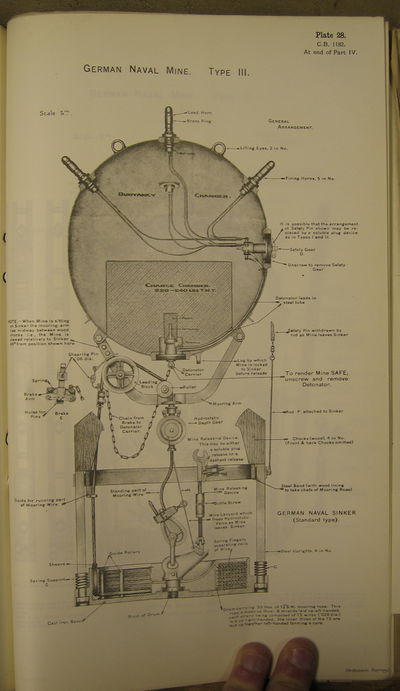Type III Mine (DE)

The German Type III Mine was intended to replace the earlier Type I and possibly also the Type II mines. These were mines of a complete design for general use. This article is based, initially, on a British report on German mines from July, 1917.[2]
| Type III Mine | |
| Weight | 620 lbs. |
| Casing | 0.2 in. welded steel |
| Trigger | five impact horns, one being on top |
| Charge | 220 lbs. T.N.T. |
| Primer | presumably tetryl |
| Detonator | 90 gr. fulminate of mercury |
| Buoyancy | 200 lbs. |
| Height | 37 in. |
| Diameter | 34 in. |
The charge was of cast T.N.T. installed through a loading hole in the bottom of the cylindrical charge chamber. A intermediate primer of compressed T.N.T. was integral to the cast warhead and surrounded the primer proper.
Some of the early Type IV mines matched these characteristics, as well. The details in the above may be wrong in that the British recorded them without ever having seen a Type III mine.
Action of Laying and Detonation
German mines of Type I through V worked in the same manner. The mine and sinker went to the bottom together. After 10 or 20 minutes, a soluble plug dissolved to release the mine, which rose under its own buoyancy, trailing the tethering cable behind. When the hydrostatic depth gear in the mine determines that its proper depth has been attained, it fired to grip the mooring cable. After this, the depth gear and grip would be locked to prevent ratcheting upward with a rising tide. The British felt the depth gear was reliable and accurate.
When a contact horn was struck and bent, a glass tube of acid would break, and its contents would flow to a bichromate battery to energise it, causing the detonator to fire. This action was instantaneous.
Footnotes
Bibliography
- Admiralty (July, 1917). German Navy: Part IV, Section 3. Torpedoes, Mines, Etc. (C.B. 1182) The National Archives. ADM 186/228.